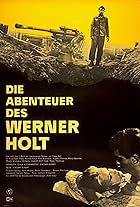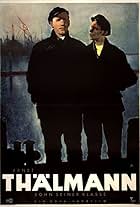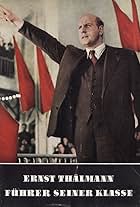एडवांस सर्च
- शीर्षक
- नाम
- सहभागिता
फिल्टर खोजें
पूरी तारीख दर्ज करें
को
या बस नीचे yyyy, या yyyy-mm दर्ज करें
को
को
को
इसे छोड़ दें
इसमें सिर्फ़ चुने गए टॉपिक्स वाले टाइटल शामिल हैं
को
मिनटों में
को
1-161 में से 50
- After landing on TEM 4 following a distress call, the crew finds Temers denying sending it. At a ruler's party, drugged food clouds their minds. Navigator Suko, alone on the ship, makes a horrific discovery.
- Eight space cargo-ships disappear without a trace within three days. And the orbit station "Margot" has suddenly fallen silent. The space council is faced with a mystery and the scientist in charge, Maria Scholl, sees no other solution than ordering a total flight stop to this mysterious sector of space. Her colleague, Prof. Tal seems to be suspicious since he knows things before they are even released. A forbidden look into his personal file brings to light that Tal was part of the Eolomea project that never found approval of the commission in charge.
- A German stage actor's cult following and popularity after protesting the 1968 invasion of Czechoslovakia
- Two teenagers are drafted into Hitler's army. One becomes fanatical, while the other realizes war's senselessness. When his friend is executed, the disillusioned soldier turns against his own forces in this anti-war film based on a novel.
- In the little town of Herzsprung - whose name harks back to an ancient legend of broken hearts - almost nothing has changed since German unification, except a rise in unemployment. Johanna, a young mother and widow, becomes one of the unemployed and lives on welfare. To make matters worse, she falls in love with a dark-skinned, roving adventurer and the whole village starts talking about it. Director Helke Misselwitz became internationally known for her documentary Winter Adé (1988), about women in the final years of the GDR. Herzsprung was her feature film debut. The lyrics for the song, "Oh, Your First Love," sung by Eva-Maria Hagen, were adapted by singer-songwriter Wolf Biermann, expelled from the GDR in 1976.
- Whites expel Dakotas from Black Hills after finding gold, defying treaty. Chief's son Tokei-ihto rejects barren reservation after his father's murder. Out of prison, he leads tribe's flight to Canada, confronting murderer Red Fox.
- The successful entertainment artist Ralf Keul must develop his land on the Baltic Sea or else ultimately give it up. Inexperienced yet courageous, he hurls himself into the undertaking, which spares him no unpleasantness. He battles over the transportation and procurement of materials, constantly on the verge of a nervous breakdown, while his craftsmen offer little additional assistance. About halfway through the project he runs out of money and ends up selling his coin collection. Finally, after countless stresses, job-related irritations, and overlapping marital crises, the house is built. His wife and daughter are thrilled, and enthusiastic visitors show up in droves.
- Ten-year-old Ernst wants to go on a bike ride with his father Alfons, but his mother decides that they should all go to Seifertsgrün together for their golden wedding anniversary. Finally, she is persuaded to let the two of them ride their bikes if they promise to arrive on time. Ernst and Alfons set off - from Mecklenburg to the Erzgebirge. It is a journey with many obstacles and adventurous experiences, because Alfons intervenes wherever help is needed. Among other things, he saves a skydiver's bride who has landed in a tree in her wedding dress. The agreed time draws ever closer, and father and son are still a long way from Seifertsgrün. But they too get help and land at the banquet table in an airplane.
- Nine-year old George, son of British settlers, is kidnapped by Iroquois and raised by the chief who adopts him. Later he gets the chance to return to his family but refuses because he has discovered that the palefaces are the true savages.
- During Great Depression, a family is evicted from their apartment and with no other option they move to a tent camp called Kuhle Wampe.
- In this film, Wolf and scriptwriter Wolfgang Kohlhaase explore the role of art and the artist in socialist society. A sculptor questions the reception and value of his work, in a delicately nuanced narrative interweaving personal memories, historical dilemmas, and political defeats.
- Once upon a time, there lived a lazy miller who spent all his time drinking wine and telling stories. When the king's treasurer comes to him with a demand to pay the tax, the miller lies that his daughter Marie can spin gold from straw.
- This historical-biographical film begins in the first days of November 1918 on the western front. News comes to the soldiers of a revolutionary uprising in Kiel. Young Thälmann, a soldier against his will, would like to join the expanding conflict on the side of his comrades in Hamburg. As the revolution becomes threatened by the betrayal of the right-wing Social Democrats and the splintering of the working class, he nevertheless tries unremittingly to unite the workers. The reactionaries grow ever stronger and the neediness of ordinary people multiplies. In this dire situation, the Hamburg police commissioner would like to block the unloading of a ship full of provisions that were sent from Petrograd as a message of solidarity. But Thälmann prevails in unloading it. The high point and conclusion of the first part of the Thälmann films is established at the Hamburg Uprising in October 1923.
- Fall 1989: Jan is almost 16. Caught while trying to escape to West Germany, he is transferred from prison to a juvenile detention center. Here, he meets Jana ... and what starts as a bet, becomes true love. When Jana gets pregnant, the situation spirals out of control. In the summer of 1990, Jana and Jan flee into the unknown, insecure future of a new Germany. In this film, the director, internationally known for his critical films about children and young people, cast non-professional actors - some from juvenile detention centers - in the leading roles.
- Little Sabine has spent her childhood in an orphanage after her parents died in a car accident. When one of the women in charge at the orphanage, Edith, leaves to have a baby, Sabine runs away, because Edith was the only adult there she could trust. She then wanders through the city to find someone to take her in. She meets a lot of people on her journey, but she seems out of place everywhere she goes until, at last, she realizes that there is a special place where she belongs.
- Rebellious young Werther is passionately, but hopelessly, in love with Lotte. Although he knows that she is married to somebody who can offer her a secure future, Werther tries to be near her. Lotte cannot decide between these two men. She eventually rejects Werther, who does not survive her decision. Based on the novel by Goethe. Director Egon Günther and set designer Helga Schütz make cameo appearances.
- Farsighted Falcon, the Dakota chief, seeks refuge in the Black Hills with his wife Blue Hair and two warriors, the sole survivors of his tribe, in order to join part of the Cheyenne headed by Chief Little Wolf. On the way, they are attacked by the bandit Jim Bashan and his gang. On the orders of mining boss Harrington, Bashan is terrorizing the inhabitants of Tanglewood and regularly stealing goods from the successful trader Sam Blake. Blue Hair is shot by Bashan from behind. Farsighted Falcon pursues him to Tanglewood where he befriends Sheriff Patterson, an honorable man, who wants to help him. Together, they prevent a raid on a shipment of money belonging to Blake. Patterson tries to prove to the incensed citizens of Tanglewood that Bashan is behind the robberies, but the city had surrendered itself to the mining company long ago. Boss Harrington now gives the orders. He revokes the sheriff's badge and incites the whites to lynch the Indians. Although Farsighted Falcon manages to kill Blue Hair's murderer, he falls victim to the the whites' powerlust.
- After WWII, Berlin lies in ruins. For Gustav, Willi and their friends the rubble provides an adventurous, dangerous playground. Especially for Gustav, it helps pass the time, as he longs for his father's return from a POW camp. One day a stranger arrives, looking helpless and hopeless... Gerhard Lamprecht built his reputation during the 1920s and '30s with films like Emil and the Detectives (1931, script Billy Wilder) and socially-critical Berlin films based on the drawings of Heinrich Zille. In Somewhere in Berlin-his first postwar film, made just months after the cessation of hostilities-he portrays the people of the shattered city with precision and psychological realism.
- At the beginning of the 19th century, white settlers regularly make and break treaties with the Native American inhabitants to gain possession of vast hunting grounds at ludicrously low prices without any bloodshed. Harrison, Governor of Indiana, has made and broke no less than fifteen such treaties, driving increasing numbers of Indians out to the infertile West. To put a stop to this criminal practice, the Shawnee Chief Tecumseh tries to unite the Native Americans. In 1811, he founds a tribal alliance and has Native American lands declared communal property. Chiefs who sell their land in spite of this agreement are to be killed. During the chief's absence, however, Harrison raids the "sacred city" of Tippecanoe founded by Tecumseh and his supporters, reducing it to ashes. The few survivors of the bloodbath flee to Canada, where they join forces with the English as they wage war against America. But they, too, fail to keep their promise to Tecumseh concerning an independent Indian state. In a decisive battle, the defeated English betray and abandon their Native American allies. Together with the other members of his tribe, Tecumseh is killed too.
- In the latter half of the 19th century, gold is discovered in the Black Hills, an area which has already been allocated to the Dakota Indians as a winter reservation in a treaty. Nevertheless, gold diggers, profiteers and adventurers flock to the region. Among them is the hard-hearted land speculator Bludgeon, who tries to expel the Indians using brutal methods like slaughtering entire herds of buffalo. The Dakotas take their revenge by attacking a Union Pacific train. While Chief Farsighted Falcon and his men are out hunting, Bludgeon and his gang massacre the Indian village. The Dakota warriors retaliate and soon the gold diggers' town becomes the scene of a giant battle. Only the advancing cavalry manage to head off certain defeat for the Whites. Farsighted Falcon conquers Bludgeon in single combat, however. Gathering up the remaining members of his tribe, he leads them to safety elsewhere.
- The second part of the Ernst Thälmann films encompasses the time period between 1930 and Thälmann's murder in 1944. It shows Thälmann's battle to achieve a united front with all German workers against the National Socialists, his arrest following Hitler's seizure of power and the eleven years of his incarceration, in which he is unwavering in his beliefs until his death. An attempt to free him on the part of his comrades ends disastrously, and a corrupt offer of freedom from Göring himself receives Thälmann's refusal. He must also witness how his brave fellow Socialist Aenne Jansen in the women's prison across from his tragically loses her life during a bombing raid. The second primary character of the film is Aenne's husband Fiete Jansen, who already proved his loyalty to Thälmann's side as a friend and fighter in the first part. As the commander of the Thälmann Battalion, he fights in Spain on the side of the people and later in the ranks of the Red Army toward a speedy end to the war against Fascism.
- Farmer Has is drawn into war as a soldier. Returning from the front, having been defrauded of his pay by his own king, he makes his way home. On his trip, he encounters a witch who asks him to fetch the light from a spring. He keeps it when the witch tries to deceive him and he discovers her foul magic. When the light is ignited, a little man appears who must serve the owner of the light, but it only has power if the owner has faith in himself. His courage bolstered, Hans goes to the king once more to demand his wages be paid. He is refused again, so he kidnaps the king's daughter, who is now forced to lead Hans' household. The king's bounty hunter captures him and has already erected the gallows when an accidental gunshot delivered by an unsuspecting robber saves Hans' life.
- Susanne is a young single mother who lives a somewhat "carefree" lifestyle. After quitting her job, she finds herself in trouble financially and attempts a minor insurance fraud to make ends meet. Despite its rare view of everyday socialism from a woman's perspective, East German officials were critical of this frank portrayal of a less-than-ideal socialist citizen and turned down all invitations for the film to be screened abroad. In West Germany, however, Evelyn Schmidt's film received much praise for its critical feminist approach. The Bicycle was part of the 2005 Rebels with a Cause: The Cinema of East Germany retrospective, shown at The Museum of Modern Art, New York.
- Berlin, seven years after WWII. Four women are looking for happiness and a good man in the divided city. Their destinies are loosely connected through one person: the West Berlin dandy and womanizer, Conny. Released at the peak of East German cultural and political dogmatism, the film was heavily critiqued, especially by female party leaders who objected that its portrayal of the four women did not represent the qualities that characterized women in the new society. Now considered as a richly contradictory work, Destinies of Women represents an encore production by the Dudow/Eisler/Brecht creative team that also made Kuhle Wampe in 1932.
- DDR film from the mid-60s: Li and Al, not long married, want to divorce. They feel trapped in their marriage and in their one-room apartment. They long for an unconventional, meaningful life, but the search for meaning confounds them.
























